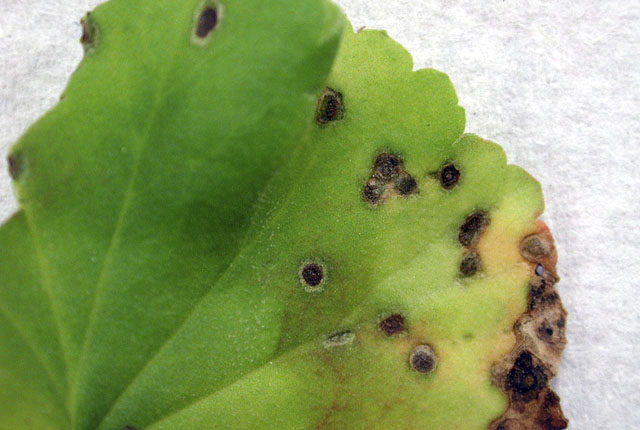
Bacterial Stain
Xanthomonas Hortorum Pv. Pelargonii
Pathogen:
Bacterium
Type:
Risk:
INTERMEDIATE




DESCRIPTION
Pathogen description
Bacterial spot, caused by the bacteria Xanthomonas hortorum, is a common disease that affects geraniums and other ornamental plants. This bacteria is pathogenic for a wide range of hosts and can cause significant damage under favorable conditions.
Disease description
Bacterial spot is characterized by the formation of small necrotic lesions on the leaves, stems and flowers of the plant. These lesions usually have a yellow or brown center surrounded by a yellowish halo, giving the disease its characteristic appearance. As the disease progresses, the lesions can fuse and cause premature defoliation of the plant, weakening it and affecting its growth and flowering.

TEMPERATURE AND HUMIDITY
25°C - 30°C
70% - 90%

VOIES DE TRANSMISSION
Direct contact, transport by irrigation water.

Chemical treatments
CONTROL
• COPPER OXYCHLORIDE 35% (exp. in Cu) [WG] P/P
• CUPROUS OXIDE 50% (EXPR. IN CU) [WP] P/P
• CUPROUS OXIDE 50% (EXPR. IN CU) [WP] P/P
• CUPROCALCIC SULFATE 20% (EXPR. IN CU) [WG] P/P
Treatments authorized in organic farming
• COPPER OXYCHLORIDE 35% (exp. in Cu) [WG] P/P
• CUPROUS OXIDE 50% (EXPR. IN CU) [WP] P/P
• CUPROUS OXIDE 50% (EXPR. IN CU) [WP] P/P
• CUPROCALCIC SULFATE 20% (EXPR. IN CU) [WG] P/P
Biological control
• BACILLUS SUBTILIS (STRAIN QST 713) 1.34% [SC] P/V
Preventive treatments
• BACILLUS SUBTILIS (STRAIN QST 713) 1.34% [SC] P/V
• COPPER OXYCHLORIDE 35% (exp. in Cu) [WG] P/P
• CUPROUS OXIDE 50% (EXPR. IN CU) [WP] P/P
• CUPROUS OXIDE 50% (EXPR. IN CU) [WP] P/P
• CUPROCALCIC SULFATE 20% (EXPR. IN CU) [WG] P/P
To prevent the appearance of bacterial spot on geranium, it is important to maintain good hygiene in the garden or in the environment where the plant is grown. It is recommended to avoid overhead irrigation, which can promote the spread of the bacteria, and use irrigation techniques that avoid wetting the leaves and stems of the plant. In addition, it is important to regularly remove disease-affected plant parts and avoid over-fertilizing, which can weaken the plant's resistance to disease.
Recommendations
*The recommended treatments are recommendations based on the authorities' databases and do not replace in any way the guidelines established by the legislation of each country.





